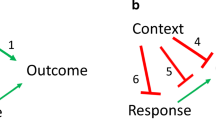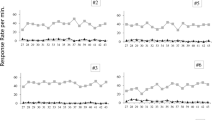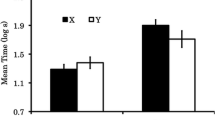Abstract
The discovery of reinforcement, extinction, generalization, and differentiation with the conditional reflex method in Pavlov’s laboratories is described. Modern American introductory texts show that contemporary understanding of the experimental work on conditioning in Pavlov’s laboratories is derived from a 1927 English translation of Pavlov’s lectures on the conditional reflexes. The lectures present the discoveries topically, not chronologically. In contrast, this article presents a chronological account of the contributions of S. G. Vul’fson, I. F. Tolochinov, and B. P. Babkin, which led to the conceptualization of reinforcement and extinction, and the work of V. N. Boldyrev and N. A. Kashereninova, which led to the formulation of the concepts of generalization and differentiation. This historical approach avoids giving the impression that the development of the Pavlovian paradigm was a highly systematic pursuit.
Similar content being viewed by others
References
Babkin, B. P. (1904)An Experiment on the Systematic Study of Complex-Nervous (Psychical) Phenomena in a Dog. St. Petersburg: Tipografiia P. V. Martynova (in Russian).
Boldyrev, V. N. (1905) The formation of artificial conditional (psychical) reflexes and their characteristics: The transformation of sounds, smells and light in artificial evocators of salivary flow. Trudy Obshchestva Russkikh Vrachei v S.-Peterburge s Prilozheniem Protokolov Zasedanii Obshchestva za 1904–1905 God,72, 321–346 (in Russian).
Boldyrev, V. N. (1906) The formation of artificial conditional (i.e. psychic) reflexes and their characteristics: The transformation of the localized cooling of the skin as evocator of salivary flow. Trudy Obshchestva Russkikh Vrachei v S.-Peterburge s Prilozheniem Protokolov Zasedanii Obshchestva za 1905–1906 God,73, 198–228 (in Russian).
Kashereninova, N. A. (1906) A new artificial salivary conditional reflex. Trudy Obshchestva Russkikh Vrachei v S.-Peterburge s Prilozheniem Protokolov Zasedanii Obshchestva za 1905–1906 God,73, 283–287 (in Russian).
Kashereninova, N. A. (1908)Contributions Toward the Study of Conditional Salivary Reflexes in Response to the Tactile Stimulation of a Dog’s Skin. St. Petersburg: Tipografiia Shtaba Otdelnago Korpusa Zhandarmov (in Russian).
Kvasov, D. G., and Fedorova-Grot, A. K. (1967)The Physiological School of I. P. Pavlov. Leningrad: Izdatel’stvo Nauka (in Russian).
Orbeli, L. A. (1966)Reminiscences. Moscow, Leningrad: Izdatel’stvo “Nauka” (in Russian).
Pavlov, I. P. (1927)Conditioned Reflexes, an Investigation of the Physiological Activity of the Cerebral Cortex. G. V. Anrep (Ed. and Trans.). London: Oxford University Press, Humphrey Milford.
Pavlov, I. P. (1951) Lectures on the functions of the cerebral hemispheres. Polnoe Sobranie Sochinenii. Moscow, Leningrad: Izdatel’stvo Akademii Nauk SSSR, Vol. 4 (in Russian).
Tolochinov, I. F. (1912) The initial development of the method of conditional reflexes and the formulation of the term “conditional reflex.” Russkii Vrach,31, 1277–1282 (in Russian).
Tolochinov, I. (1903) Contribution to the study of the physiology and psychology of salivary glands (in French).Förhandlingar vid Nordiska Naturforskare- och Läkaremö tet i Helsingfors den 7 till 12 Juli 1902. Helsingfors: Helsingfors Centraltryckeri & Bokbinderaktiebolag.
Vul’fson, S. G. (1898) The Function of Salivary Glands. St. Petersburg: Trenke i Fiusno (in Russian).
Windholz, G. (1986) A comparative analysis of the conditional reflex discoveries of Pavlov and Twitmyer, and the birth of a paradigm.Pavlovian Journal of Biological Science, 1986,21, 141–147.
Author information
Authors and Affiliations
Rights and permissions
About this article
Cite this article
Windholz, G. The discovery of the principles of reinforcement, extinction, generalization, and differentiation of conditional reflexes in Pavlov’s laboratories. Pav. J. Biol. Sci. 24, 35–42 (1989). https://doi.org/10.1007/BF02964534
Issue Date:
DOI: https://doi.org/10.1007/BF02964534




